SUBARU WRX 2018 Workshop Manual
Manufacturer: SUBARU, Model Year: 2018, Model line: WRX, Model: SUBARU WRX 2018Pages: 578, PDF Size: 33.21 MB
Page 51 of 578
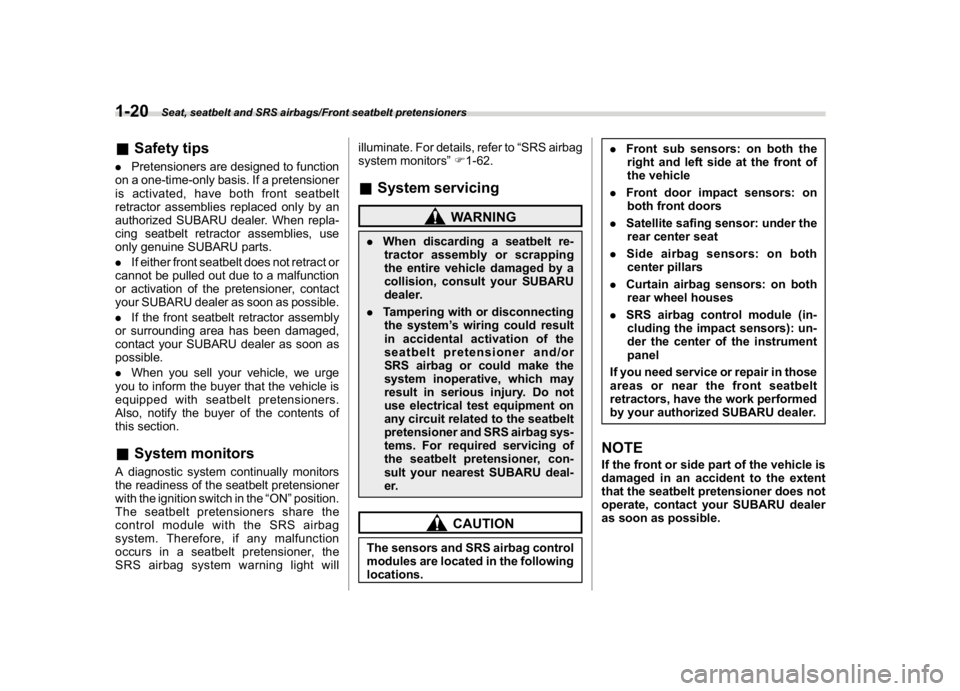
(52,1)
北米Model "A1700BE-B" EDITED: 2017/ 10/ 11
&Safety tips.Pretensioners are designed to function
on a one-time-only basis. If a pretensioner
is activated, have both front seatbelt
retractor assemblies replaced only by an
authorized SUBARU dealer. When repla-
cing seatbelt retractor assemblies, use
only genuine SUBARU parts.
.If either front seatbelt does not retract or
cannot be pulled out due to a malfunction
or activation of the pretensioner, contact
your SUBARU dealer as soon as possible.
.If the front seatbelt retractor assembly
or surrounding area has been damaged,
contact your SUBARU dealer as soon as
possible.
.When you sell your vehicle, we urge
you to inform the buyer that the vehicle is
equipped with seatbelt pretensioners.
Also, notify the buyer of the contents of
this section.&System monitorsA diagnostic system continually monitors
the readiness of the seatbelt pretensioner
with the ignition switch in the“ON”position.
The seatbelt pretensioners share the
control module with the SRS airbag
system. Therefore, if any malfunction
occurs in a seatbelt pretensioner, the
SRS airbag system warning light willilluminate. For details, refer to“SRS airbag
system monitors”F1-62.
&System servicing
WARNING
.When discarding a seatbelt re-
tractor assembly or scrapping
the entire vehicle damaged by a
collision, consult your SUBARU
dealer.
.Tampering with or disconnecting
the system’s wiring could result
in accidental activation of the
seatbelt pretensioner and/or
SRS airbag or could make the
system inoperative, which may
result in serious injury. Do not
use electrical test equipment on
any circuit related to the seatbelt
pretensioner and SRS airbag sys-
tems. For required servicing of
the seatbelt pretensioner, con-
sult your nearest SUBARU deal-
er.
CAUTION
The sensors and SRS airbag control
modules are located in the following
locations..Front sub sensors: on both the
right and left side at the front of
the vehicle
.Front door impact sensors: on
both front doors
.Satellite safing sensor: under the
rear center seat
.Side airbag sensors: on both
center pillars
.Curtain airbag sensors: on both
rear wheel houses
.SRS airbag control module (in-
cluding the impact sensors): un-
der the center of the instrument
panel
If you need service or repair in those
areas or near the front seatbelt
retractors, have the work performed
by your authorized SUBARU dealer.
NOTEIf the front or side part of the vehicle is
damaged in an accident to the extent
that the seatbelt pretensioner does not
operate, contact your SUBARU dealer
as soon as possible.
Seat, seatbelt and SRS airbags/Front seatbelt pretensioners
1-20
Page 52 of 578
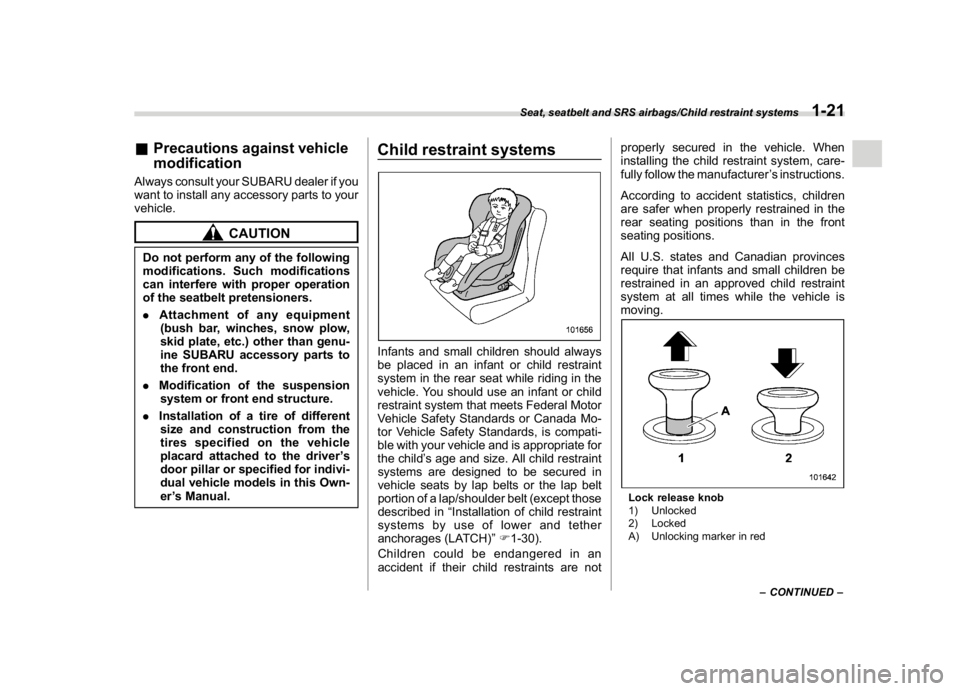
(53,1)
北米Model "A1700BE-B" EDITED: 2017/ 10/ 11
&Precautions against vehicle
modificationAlways consult your SUBARU dealer if you
want to install any accessory parts to your
vehicle.
CAUTION
Do not perform any of the following
modifications. Such modifications
can interfere with proper operation
of the seatbelt pretensioners.
.Attachment of any equipment
(bush bar, winches, snow plow,
skid plate, etc.) other than genu-
ine SUBARU accessory parts to
the front end.
.Modification of the suspension
system or front end structure.
.Installation of a tire of different
size and construction from the
tires specified on the vehicle
placard attached to the driver’s
door pillar or specified for indivi-
dual vehicle models in this Own-
er’s Manual.
Child restraint systemsInfants and small children should always
be placed in an infant or child restraint
system in the rear seat while riding in the
vehicle. You should use an infant or child
restraint system that meets Federal Motor
Vehicle Safety Standards or Canada Mo-
tor Vehicle Safety Standards, is compati-
ble with your vehicle and is appropriate for
the child’s age and size. All child restraint
systems are designed to be secured in
vehicle seats by lap belts or the lap belt
portion of a lap/shoulder belt (except those
described in“Installation of child restraint
systems by use of lower and tether
anchorages (LATCH)”F1-30).
Children could be endangered in an
accident if their child restraints are notproperly secured in the vehicle. When
installing the child restraint system, care-
fully follow the manufacturer’s instructions.
According to accident statistics, children
are safer when properly restrained in the
rear seating positions than in the front
seating positions.
All U.S. states and Canadian provinces
require that infants and small children be
restrained in an approved child restraint
system at all times while the vehicle is
moving.
Lock release knob
1) Unlocked
2) Locked
A) Unlocking marker in red
–CONTINUED–
Seat, seatbelt and SRS airbags/Child restraint systems
1-21
1
Page 53 of 578
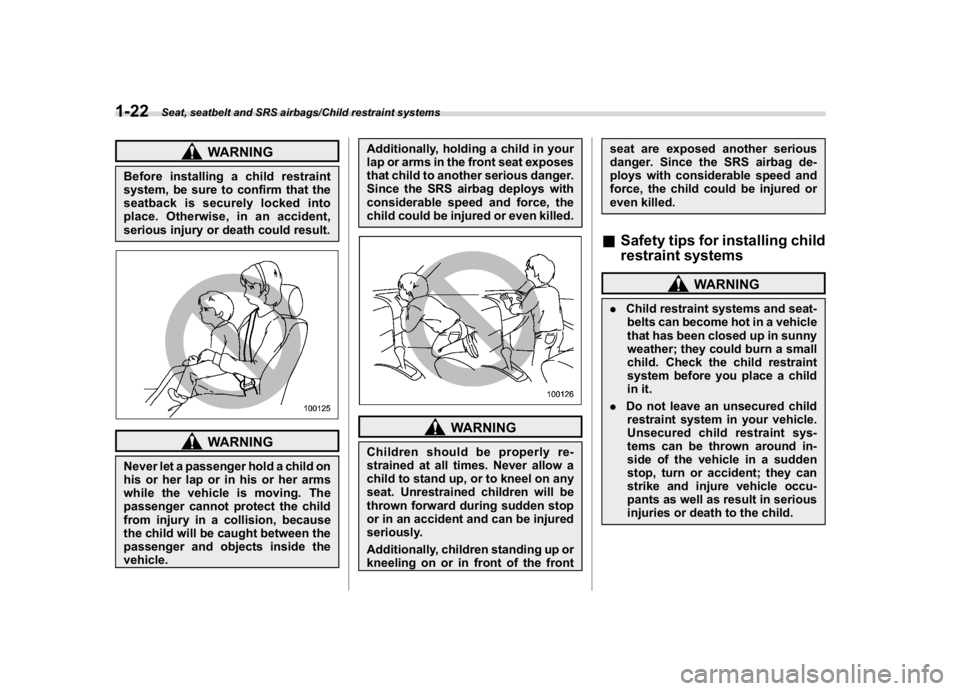
(54,1)
北米Model "A1700BE-B" EDITED: 2017/ 10/ 11
WARNING
Before installing a child restraint
system, be sure to confirm that the
seatback is securely locked into
place. Otherwise, in an accident,
serious injury or death could result.
WARNING
Never let a passenger hold a child on
his or her lap or in his or her arms
while the vehicle is moving. The
passenger cannot protect the child
from injury in a collision, because
the child will be caught between the
passenger and objects inside the
vehicle.Additionally, holding a child in your
lap or arms in the front seat exposes
that child to another serious danger.
Since the SRS airbag deploys with
considerable speed and force, the
child could be injured or even killed.
WARNING
Children should be properly re-
strained at all times. Never allow a
child to stand up, or to kneel on any
seat. Unrestrained children will be
thrown forward during sudden stop
or in an accident and can be injured
seriously.
Additionally, children standing up or
kneeling on or in front of the frontseat are exposed another serious
danger. Since the SRS airbag de-
ploys with considerable speed and
force, the child could be injured or
even killed.
&Safety tips for installing child
restraint systems
WARNING
.Child restraint systems and seat-
belts can become hot in a vehicle
that has been closed up in sunny
weather; they could burn a small
child. Check the child restraint
system before you place a child
in it.
.Do not leave an unsecured child
restraint system in your vehicle.
Unsecured child restraint sys-
tems can be thrown around in-
side of the vehicle in a sudden
stop, turn or accident; they can
strike and injure vehicle occu-
pants as well as result in serious
injuries or death to the child.
Seat, seatbelt and SRS airbags/Child restraint systems
1-22
Page 54 of 578
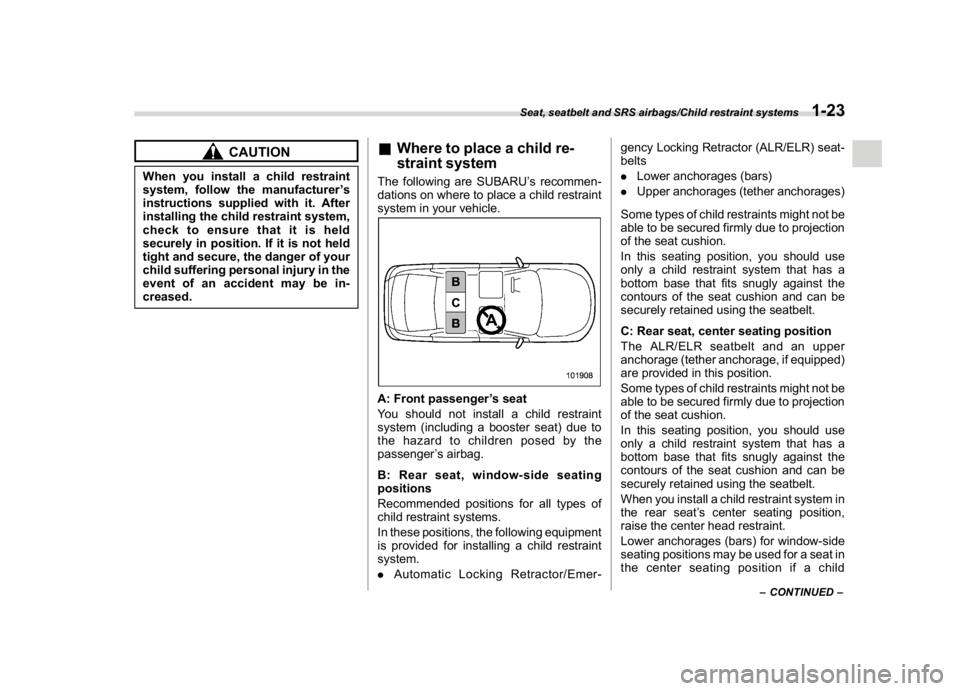
(55,1)
北米Model "A1700BE-B" EDITED: 2017/ 10/ 11
CAUTION
When you install a child restraint
system, follow the manufacturer’s
instructions supplied with it. After
installing the child restraint system,
check to ensure that it is held
securely in position. If it is not held
tight and secure, the danger of your
child suffering personal injury in the
event of an accident may be in-
creased.
&Where to place a child re-
straint systemThe following are SUBARU’s recommen-
dations on where to place a child restraint
system in your vehicle.A: Front passenger’s seat
You should not install a child restraint
system (including a booster seat) due to
the hazard to children posed by the
passenger’s airbag.
B: Rear seat, window-side seating
positions
Recommended positions for all types of
child restraint systems.
In these positions, the following equipment
is provided for installing a child restraint
system.
.Automatic Locking Retractor/Emer-gency Locking Retractor (ALR/ELR) seat-
belts
.Lower anchorages (bars)
.Upper anchorages (tether anchorages)
Some types of child restraints might not be
able to be secured firmly due to projection
of the seat cushion.
In this seating position, you should use
only a child restraint system that has a
bottom base that fits snugly against the
contours of the seat cushion and can be
securely retained using the seatbelt.
C: Rear seat, center seating position
The ALR/ELR seatbelt and an upper
anchorage (tether anchorage, if equipped)
are provided in this position.
Some types of child restraints might not be
able to be secured firmly due to projection
of the seat cushion.
In this seating position, you should use
only a child restraint system that has a
bottom base that fits snugly against the
contours of the seat cushion and can be
securely retained using the seatbelt.
When you install a child restraint system in
the rear seat’s center seating position,
raise the center head restraint.
Lower anchorages (bars) for window-side
seating positions may be used for a seat in
the center seating position if a child
–CONTINUED–
Seat, seatbelt and SRS airbags/Child restraint systems
1-23
1
Page 55 of 578
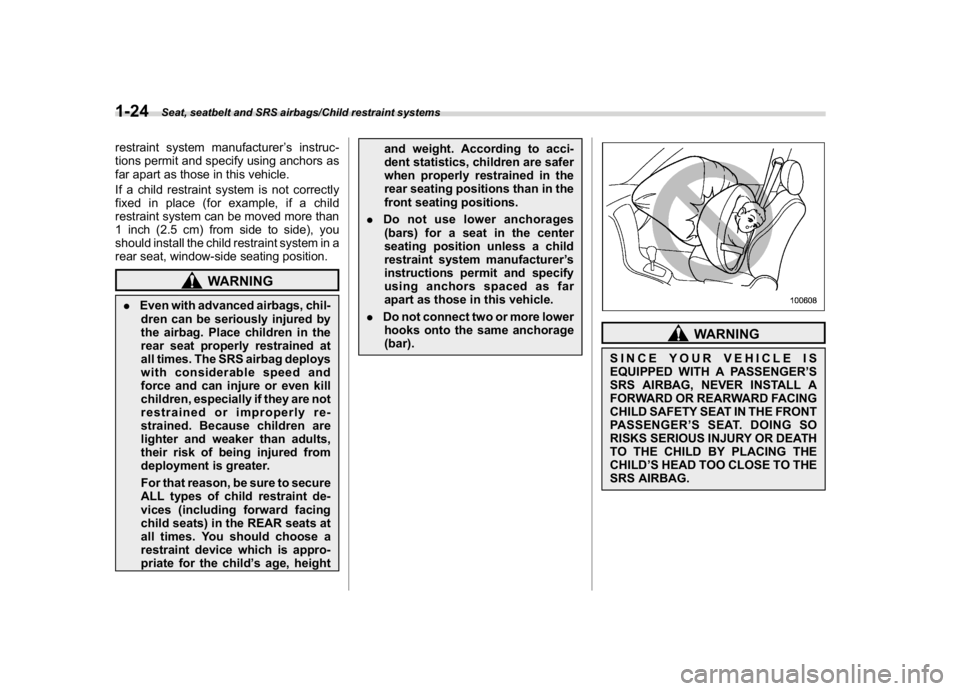
(56,1)
北米Model "A1700BE-B" EDITED: 2017/ 10/ 11
restraint system manufacturer’s instruc-
tions permit and specify using anchors as
far apart as those in this vehicle.
If a child restraint system is not correctly
fixed in place (for example, if a child
restraint system can be moved more than
1 inch (2.5 cm) from side to side), you
should install the child restraint system in a
rear seat, window-side seating position.
WARNING
.Even with advanced airbags, chil-
dren can be seriously injured by
the airbag. Place children in the
rear seat properly restrained at
all times. The SRS airbag deploys
with considerable speed and
force and can injure or even kill
children, especially if they are not
restrained or improperly re-
strained. Because children are
lighter and weaker than adults,
their risk of being injured from
deployment is greater.
For that reason, be sure to secure
ALL types of child restraint de-
vices (including forward facing
child seats) in the REAR seats at
all times. You should choose a
restraint device which is appro-
priate for the child’s age, heightand weight. According to acci-
dent statistics, children are safer
when properly restrained in the
rear seating positions than in the
front seating positions.
.Do not use lower anchorages
(bars) for a seat in the center
seating position unless a child
restraint system manufacturer’s
instructions permit and specify
using anchors spaced as far
apart as those in this vehicle.
.Do not connect two or more lower
hooks onto the same anchorage
(bar).
WARNING
SINCE YOUR VEHICLE IS
EQUIPPED WITH A PASSENGER’S
SRS AIRBAG, NEVER INSTALL A
FORWARD OR REARWARD FACING
CHILD SAFETY SEAT IN THE FRONT
PASSENGER’S SEAT. DOING SO
RISKS SERIOUS INJURY OR DEATH
TO THE CHILD BY PLACING THE
CHILD’S HEAD TOO CLOSE TO THE
SRS AIRBAG.
Seat, seatbelt and SRS airbags/Child restraint systems
1-24
Page 56 of 578
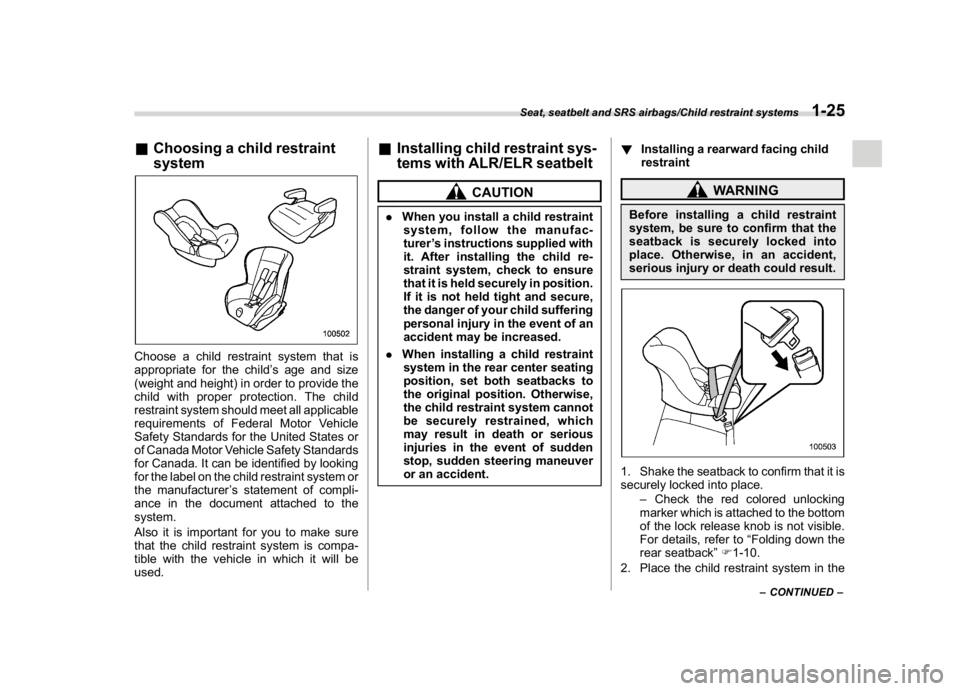
(57,1)
北米Model "A1700BE-B" EDITED: 2017/ 10/ 11
&Choosing a child restraint
systemChoose a child restraint system that is
appropriate for the child’s age and size
(weight and height) in order to provide the
child with proper protection. The child
restraint system should meet all applicable
requirements of Federal Motor Vehicle
Safety Standards for the United States or
of Canada Motor Vehicle Safety Standards
for Canada. It can be identified by looking
for the label on the child restraint system or
the manufacturer’s statement of compli-
ance in the document attached to the
system.
Also it is important for you to make sure
that the child restraint system is compa-
tible with the vehicle in which it will be
used.
&Installing child restraint sys-
tems with ALR/ELR seatbelt
CAUTION
.When you install a child restraint
system, follow the manufac-
turer’s instructions supplied with
it. After installing the child re-
straint system, check to ensure
that it is held securely in position.
If it is not held tight and secure,
the danger of your child suffering
personal injury in the event of an
accident may be increased.
.When installing a child restraint
system in the rear center seating
position, set both seatbacks to
the original position. Otherwise,
the child restraint system cannot
be securely restrained, which
may result in death or serious
injuries in the event of sudden
stop, sudden steering maneuver
or an accident.!Installing a rearward facing child
restraint
WARNING
Before installing a child restraint
system, be sure to confirm that the
seatback is securely locked into
place. Otherwise, in an accident,
serious injury or death could result.1. Shake the seatback to confirm that it is
securely locked into place.
–Check the red colored unlocking
marker which is attached to the bottom
of the lock release knob is not visible.
For details, refer to“Folding down the
rear seatback”F1-10.
2. Place the child restraint system in the
–CONTINUED–
Seat, seatbelt and SRS airbags/Child restraint systems
1-25
1
Page 57 of 578
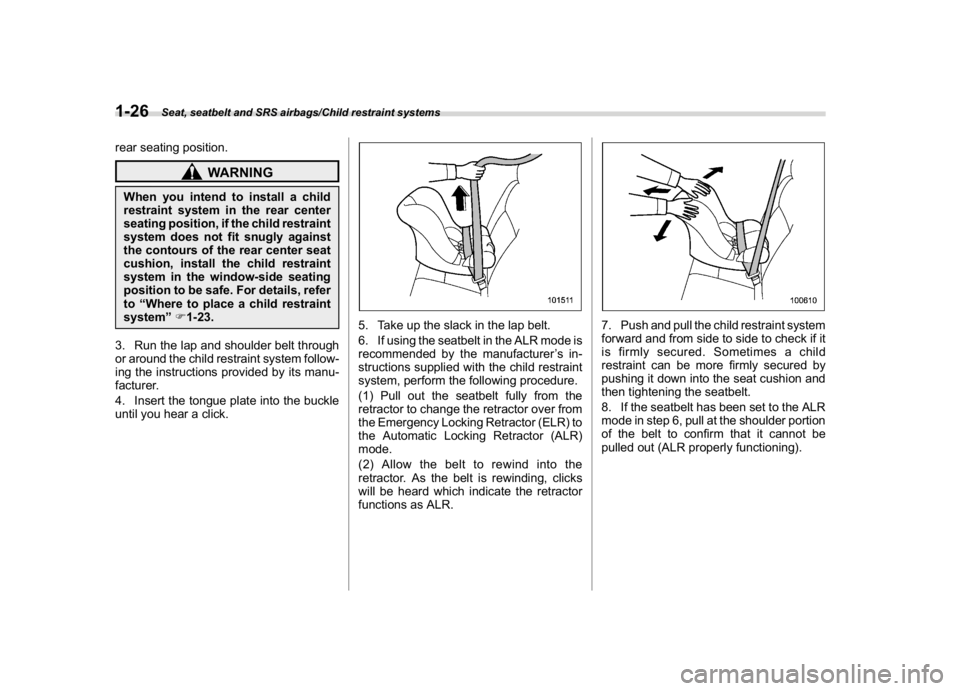
(58,1)
北米Model "A1700BE-B" EDITED: 2017/ 10/ 11
rear seating position.
WARNING
When you intend to install a child
restraint system in the rear center
seating position, if the child restraint
system does not fit snugly against
the contours of the rear center seat
cushion, install the child restraint
system in the window-side seating
position to be safe. For details, refer
to“Where to place a child restraint
system”F1-23.
3. Run the lap and shoulder belt through
or around the child restraint system follow-
ing the instructions provided by its manu-
facturer.
4. Insert the tongue plate into the buckle
until you hear a click.
5. Take up the slack in the lap belt.
6. If using the seatbelt in the ALR mode is
recommended by the manufacturer’s in-
structions supplied with the child restraint
system, perform the following procedure.
(1) Pull out the seatbelt fully from the
retractor to change the retractor over from
the Emergency Locking Retractor (ELR) to
the Automatic Locking Retractor (ALR)
mode.
(2) Allow the belt to rewind into the
retractor. As the belt is rewinding, clicks
will be heard which indicate the retractor
functions as ALR.
7. Push and pull the child restraint system
forward and from side to side to check if it
is firmly secured. Sometimes a child
restraint can be more firmly secured by
pushing it down into the seat cushion and
then tightening the seatbelt.
8. If the seatbelt has been set to the ALR
mode in step 6, pull at the shoulder portion
of the belt to confirm that it cannot be
pulled out (ALR properly functioning).
Seat, seatbelt and SRS airbags/Child restraint systems
1-26
Page 58 of 578
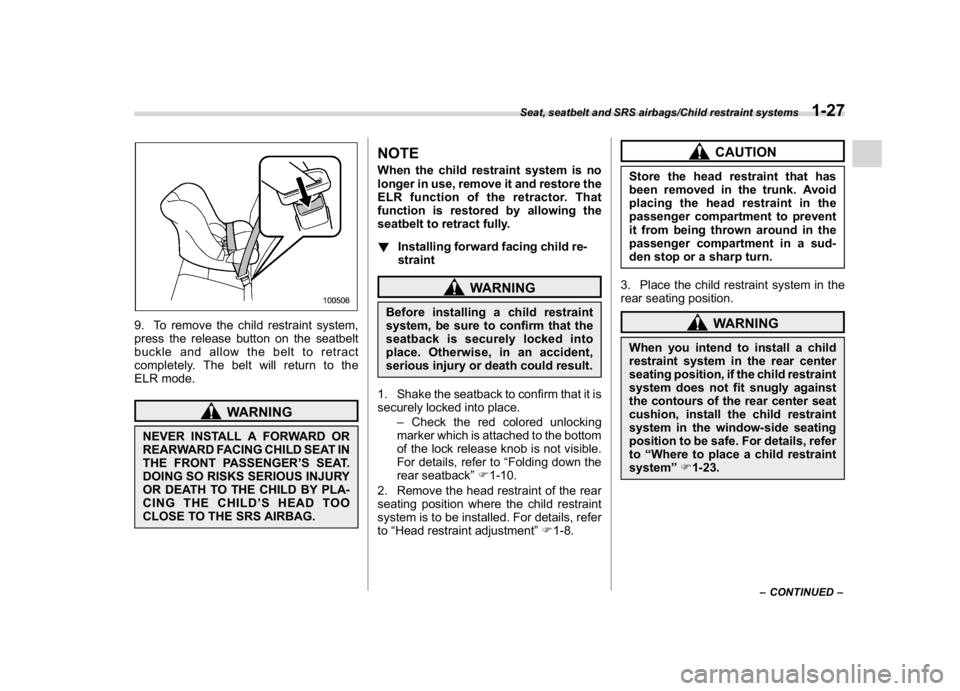
(59,1)
北米Model "A1700BE-B" EDITED: 2017/ 10/ 11
9. To remove the child restraint system,
press the release button on the seatbelt
buckle and allow the belt to retract
completely. The belt will return to the
ELR mode.
WARNING
NEVER INSTALL A FORWARD OR
REARWARD FACING CHILD SEAT IN
THE FRONT PASSENGER’S SEAT.
DOING SO RISKS SERIOUS INJURY
OR DEATH TO THE CHILD BY PLA-
CING THE CHILD’SHEADTOO
CLOSE TO THE SRS AIRBAG.
NOTEWhen the child restraint system is no
longer in use, remove it and restore the
ELR function of the retractor. That
function is restored by allowing the
seatbelt to retract fully.
!Installing forward facing child re-
straint
WARNING
Before installing a child restraint
system, be sure to confirm that the
seatback is securely locked into
place. Otherwise, in an accident,
serious injury or death could result.
1. Shake the seatback to confirm that it is
securely locked into place.
–Check the red colored unlocking
marker which is attached to the bottom
of the lock release knob is not visible.
For details, refer to“Folding down the
rear seatback”F1-10.
2. Remove the head restraint of the rear
seating position where the child restraint
system is to be installed. For details, refer
to“Head restraint adjustment”F1-8.
CAUTION
Store the head restraint that has
been removed in the trunk. Avoid
placing the head restraint in the
passenger compartment to prevent
it from being thrown around in the
passenger compartment in a sud-
den stop or a sharp turn.
3. Place the child restraint system in the
rear seating position.
WARNING
When you intend to install a child
restraint system in the rear center
seating position, if the child restraint
system does not fit snugly against
the contours of the rear center seat
cushion, install the child restraint
system in the window-side seating
position to be safe. For details, refer
to“Where to place a child restraint
system”F1-23.
–CONTINUED–
Seat, seatbelt and SRS airbags/Child restraint systems
1-27
1
Page 59 of 578
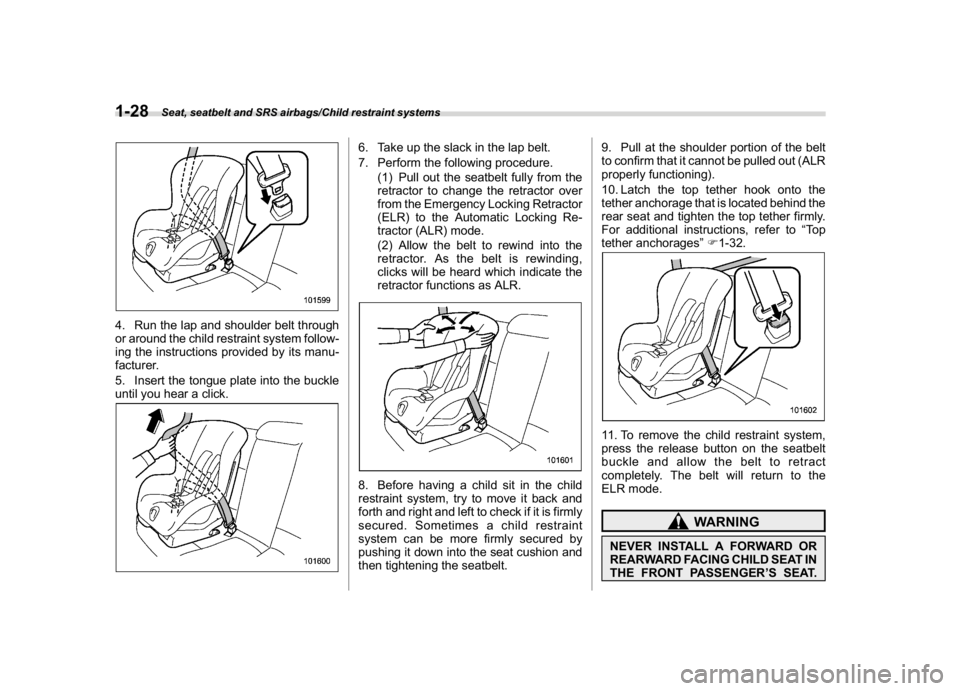
(60,1)
北米Model "A1700BE-B" EDITED: 2017/ 10/ 11
4. Run the lap and shoulder belt through
or around the child restraint system follow-
ing the instructions provided by its manu-
facturer.
5. Insert the tongue plate into the buckle
until you hear a click.
6. Take up the slack in the lap belt.
7. Perform the following procedure.
(1) Pull out the seatbelt fully from the
retractor to change the retractor over
from the Emergency Locking Retractor
(ELR) to the Automatic Locking Re-
tractor (ALR) mode.
(2) Allow the belt to rewind into the
retractor. As the belt is rewinding,
clicks will be heard which indicate the
retractor functions as ALR.8. Before having a child sit in the child
restraint system, try to move it back and
forth and right and left to check if it is firmly
secured. Sometimes a child restraint
system can be more firmly secured by
pushing it down into the seat cushion and
then tightening the seatbelt.9. Pull at the shoulder portion of the belt
to confirm that it cannot be pulled out (ALR
properly functioning).
10. Latch the top tether hook onto the
tether anchorage that is located behind the
rear seat and tighten the top tether firmly.
For additional instructions, refer to“To p
tether anchorages”F1-32.
11. To remove the child restraint system,
press the release button on the seatbelt
buckle and allow the belt to retract
completely. The belt will return to the
ELR mode.
WARNING
NEVER INSTALL A FORWARD OR
REARWARD FACING CHILD SEAT IN
THE FRONT PASSENGER’S SEAT.
Seat, seatbelt and SRS airbags/Child restraint systems
1-28
Page 60 of 578
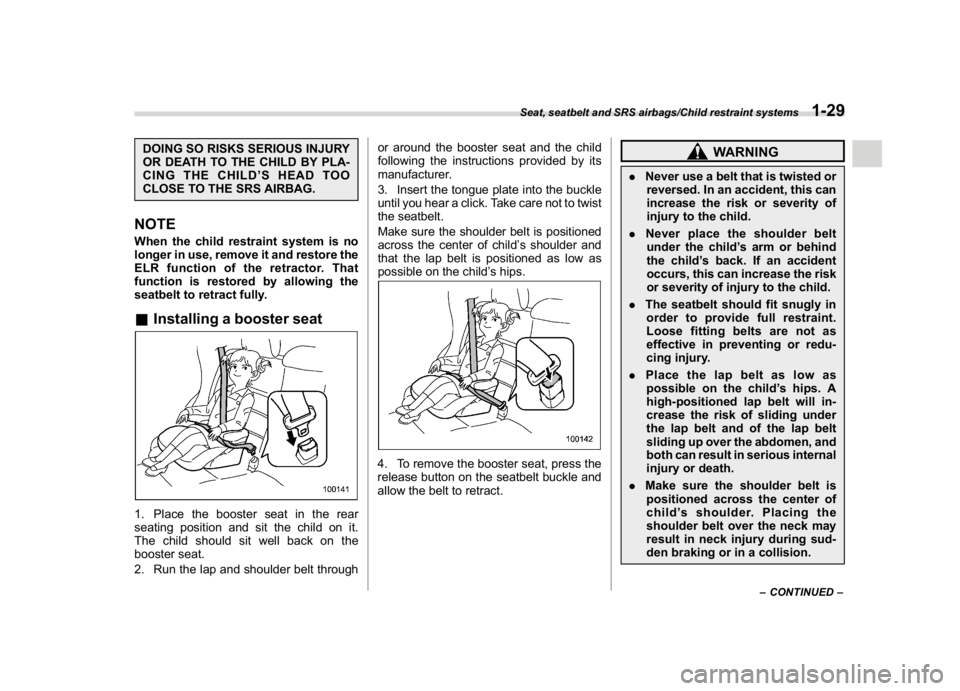
(61,1)
北米Model "A1700BE-B" EDITED: 2017/ 10/ 11
DOING SO RISKS SERIOUS INJURY
OR DEATH TO THE CHILD BY PLA-
CING THE CHILD’SHEADTOO
CLOSE TO THE SRS AIRBAG.NOTEWhen the child restraint system is no
longer in use, remove it and restore the
ELR function of the retractor. That
function is restored by allowing the
seatbelt to retract fully.&Installing a booster seat1. Place the booster seat in the rear
seating position and sit the child on it.
The child should sit well back on the
booster seat.
2. Run the lap and shoulder belt throughor around the booster seat and the child
following the instructions provided by its
manufacturer.
3. Insert the tongue plate into the buckle
until you hear a click. Take care not to twist
the seatbelt.
Make sure the shoulder belt is positioned
across the center of child’s shoulder and
that the lap belt is positioned as low as
possible on the child’s hips.
4. To remove the booster seat, press the
release button on the seatbelt buckle and
allow the belt to retract.
WARNING
.Never use a belt that is twisted or
reversed. In an accident, this can
increase the risk or severity of
injury to the child.
.Never place the shoulder belt
under the child’s arm or behind
the child’s back. If an accident
occurs, this can increase the risk
or severity of injury to the child.
.The seatbelt should fit snugly in
order to provide full restraint.
Loose fitting belts are not as
effective in preventing or redu-
cing injury.
.Place the lap belt as low as
possible on the child’s hips. A
high-positioned lap belt will in-
crease the risk of sliding under
the lap belt and of the lap belt
sliding up over the abdomen, and
both can result in serious internal
injury or death.
.Make sure the shoulder belt is
positioned across the center of
child’s shoulder. Placing the
shoulder belt over the neck may
result in neck injury during sud-
den braking or in a collision.
–CONTINUED–
Seat, seatbelt and SRS airbags/Child restraint systems
1-29
1